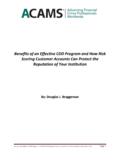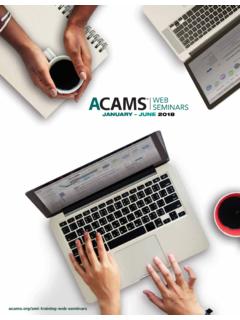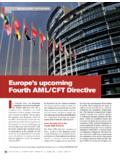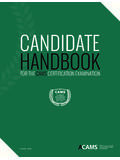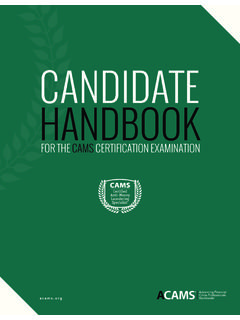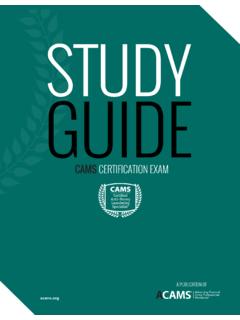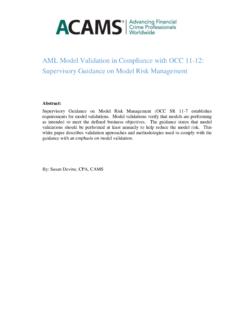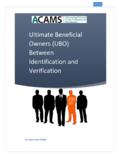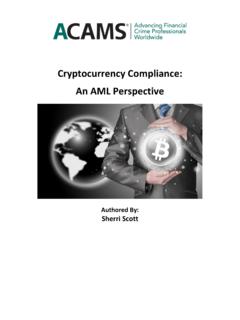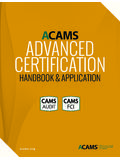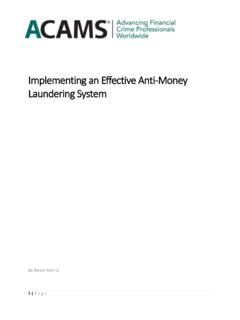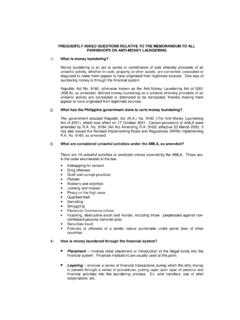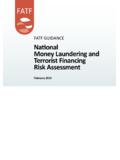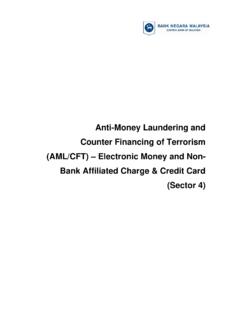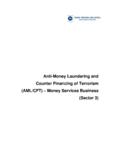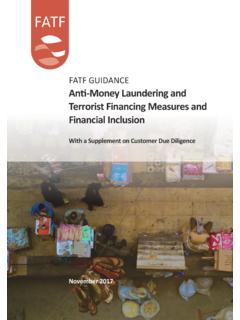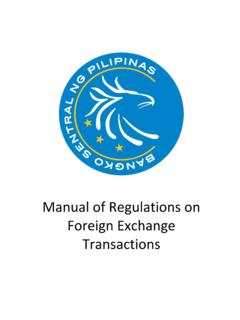Transcription of Anti-Money Laundering Compliance Program
1 1834 ChapterIntroduction n Anti-Money Laundering Program is an essential component of a financial institution s Compliance regime. The primary goal of every good Program is to protect the organization against money Laundering and to ensure that the organization is in full Compliance with relevant laws and regulations. For that reason, designing, structuring and implementing these programs should be the top priorities of any institution. An AML Program should be risk-based, and should be designed to mitigate the money Laundering and terrorist financing risks the organization may encounter.
2 The risk-based nature of the Program recognizes that not all aspects of an institution s business present the same level of risk. Certain aspects of the business a financial institution conducts will pose greater money Laundering risks than others and will require additional controls to mitigate these risks, while others will present a minimal risk and will not need the same level of attention. More detail will be provided on risk on the size of the organization, the Anti-Money Laundering function may be a stand-alone department or may Anti-Money Laundering Compliance ProgramA184 Study Guide for the CAMS Certification Examinationbe performed by persons who have other Compliance duties.
3 Regardless of the size of the organization, there should be some centralized aspect of control that has an organization-wide view of AML efforts within the organization. The AML Program should establish minimum standards for the organization that are reasonably designed to comply with applicable laws and regulations. The organization-wide Program may be supplemented by the policies and procedures of various lines of business or legal entities that address specific areas, such as private banking, trade finance, cash handling or investigations.
4 Compliance programs should also include corporate governance and overall management of money Laundering and terrorist financing risks. Before designing an Anti-Money Laundering Program , it is imperative to understand what is required of an institution, its employees and customers by the laws and regulations of the jurisdiction where the institution is located. The financial institution s internal policies and risks related to the business must also be taken into consideration. Anyone needing advice on the complexities of Anti-Money Laundering legislation before building an Anti-Money Laundering Program should consult a competent advisor, even if it means seeking outside this section, we will discuss what to consider when designing a Compliance Program ; how to assess risk; how to spot, manage, document and follow up on suspicious activities; how to know your customer and employee; how to audit your Program effectively.
5 And what you need to know about training and screening employees. Assessing Risk and Developing a Risk-Scoring ModelIntroductionUnderstanding what is legally required of your institution, employees and customers is essential to a successful Program . 185 Anti-Money Laundering Compliance ProgramWhatever those legal requirements, however, FATF, along with numerous member countries, such as the United Kingdom and United States, urge risk-based controls. The theory is that no financial institution can reasonably be expected to detect all wrongdoing by customers, including money Laundering .
6 But if an institution develops systems and procedures to detect, monitor and report the riskier customers and transactions, it will increase its chances of staying out of harm s way from criminals and from government sanctions and risk-based approach requires institutions to have systems and controls that are commensurate with the specific risks of money Laundering and terrorist financing facing them. Assessing this risk is, therefore, one of the most important steps in creating a good Anti-Money Laundering Compliance Program .
7 As money Laundering risks increase, stronger controls are necessary. However, all categories of risk whether low, medium or high must be identified and mitigated by the application of controls, such as verification of customer identity, CDD policies, suspicious activity monitoring and economic sanctions around the world believe that the risk-based approach is preferable to a more prescriptive approach in the area of Anti-Money Laundering and counter-terrorist financing because it is more: Flexible as money Laundering and terrorist financing risks vary across jurisdictions, customers, products and delivery channels, and over time.
8 Effective as companies are better equipped than legislators to effectively assess and mitigate the particular money Laundering and terrorist financing risks they face. Proportionate because a risk-based approach promotes a common sense and intelligent approach to fighting money Laundering and terrorist financing as opposed to a check the box approach. It also allows 186 Study Guide for the CAMS Certification Examinationfirms to minimize the adverse impact of Anti-Money Laundering procedures on their low-risk to DEtERMInE RISkThe risks your organization faces depend on many factors, including the geographical regions involved, your customer types and the products and services offered.
9 Risk is dynamic and needs to be continuously managed. It is critical that risk ratings accurately reflect the risks present, provide meaningful assessments that lead to practical steps to mitigate the risks, are periodically reviewed and, when necessary, are updated. Make sure you evaluate new business products for money Laundering vulnerabilities and implement appropriate controls before launching them into the what exactly is a risk-based approach, and what might a risk-scoring model look like? You can ask the following questions to assess an institution s vulnerabilities to money Laundering and terrorist financing:What Risks Do Your Customers Pose?
10 LEvELS oF RISkGenerally, all risk categories can be broken down into the following levels of risk: Prohibited The company will not tolerate any dealings of any kind given the risk. Countries subject to economic sanctions or designated as state sponsors of terrorism, such as Sudan or Iran, are prime candidates for prohibited transactions. Prohibited customers would include shell banks. High-Risk The risks here are significant, but are not necessarily prohibited. To mitigate the heightened risk presented, the firm should apply more stringent 187 Anti-Money Laundering Compliance Programcontrols to reduce the risk, such as conducting enhanced due diligence and more rigorous transaction monitoring.
